Jul
09
2018
 The USDA just ended their public comment period on their proposed execution of the terrible Federal GMO labeling law passed in 2016. The public comments reflect the mess this law is, and why it is a bad idea.
The USDA just ended their public comment period on their proposed execution of the terrible Federal GMO labeling law passed in 2016. The public comments reflect the mess this law is, and why it is a bad idea.
The law simply states that the USDA will develop rules for mandatory labeling of bioengineered food. Here is the relevant definition in the law:
‘‘In this subtitle:
‘‘(1) BIOENGINEERING.—The term ‘bioengineering’, and any similar term, as determined by the Secretary, with respect to a food, refers to a food—
‘‘(A) that contains genetic material that has been modified through in vitro recombinant deoxyribonucleic acid (DNA) techniques; and
‘‘(B) for which the modification could not otherwise be obtained through conventional breeding or found in nature.
The first criterion – in vitro recombinant DNA techniques – is at least fairly specific. However, it does not distinguish cisgenic (from a closely related species) from transgenic (from a distant species). This does not technically include gene silencing, because no new material is being sliced in. Therefore by this definition “GMO” cultivars produced through gene silencing do not need to be labeled ad BE (bioengineered).
Perhaps because this first criterion is not specific to transgenic alterations, the second criterion was added – not obtained through breeding or found in nature. The “found in nature”, however, is very problematic. This is because transgenic gene transfer does occur in nature, – so called horizontal gene transfer. In fact, recently a sweet potato variety was found to have a naturally-occurring transgene from a soil bacteria.
Continue Reading »
Jul
06
2018
 There is a strong scientific consensus that the primary driver of climate change is the release of previously sequestered carbon locked away in fossil fuels into the environment. But a new study reminds us that there is another contributor that must be accounted for in climate models – changes in land use.
There is a strong scientific consensus that the primary driver of climate change is the release of previously sequestered carbon locked away in fossil fuels into the environment. But a new study reminds us that there is another contributor that must be accounted for in climate models – changes in land use.
The core claim of climate change is actually quite simple, and has not been successfully refuted by climate change deniers. So-called “greenhouse gases” in the atmosphere warm the planet because they reflect more infrared radiation back down to the surface, so that less of it escapes the Earth. Without this effect the Earth would be a snowball.
It is irrefutable at this point that adding more greenhouse gases to the atmosphere will increase this effect, resulting in more warming. The only real question is – how much warming? This is where things become ridiculously complex. Climate scientists use models to predict what will happen as more CO2 is released into the atmosphere, but it is very difficult to model a complex system. This is why there are large error bars on projections of future warming.
As a quick aside, carbon dioxide (CO2) is not the only greenhouse gas, but it is the major one. Methane is a more potent greenhouse gas (GHG) than CO2, but it does not last as long in the atmosphere. Within the first 20 years after its release, methane is 84 times as potent a GHG than CO2, but only 34 times if you consider its effects over 100 years. Much less methane is released into the atmosphere than CO2, but it is not negligible and needs to be considered in climate models.
Continue Reading »
Jul
05
2018
 Etzel Cardeña has published an extensive review of parapsychology concluding that it is both plausible and supported by evidence. It stands, in my opinion, as an excellent example of everything that is wrong with psi research. There is a lot of meat to go through, but I want to focus in this article on his use of quantum mechanics to justify the plausibility of ESP and psi phenomena.
Etzel Cardeña has published an extensive review of parapsychology concluding that it is both plausible and supported by evidence. It stands, in my opinion, as an excellent example of everything that is wrong with psi research. There is a lot of meat to go through, but I want to focus in this article on his use of quantum mechanics to justify the plausibility of ESP and psi phenomena.
Psi, or anomalous cognition, is a group of alleged phenomena that include sensing what other people are thinking, viewing remote locations not accessible to the normal senses, and predicting the future in some way. These claims are inherently implausible because there is no way to account for them with known phenomena. They appear, therefore, to violate well-established laws of physics. Therefore, any reasonable scientists would argue, the threshold of evidence needed before concluding that a psi phenomenon is real should be very high. What we have is very low-grade evidence at best, therefore it is reasonable to reject claims for psi.
Psi proponents, therefore, attack the two pillars of this rejection – that psi is implausible, and that the evidence is low-grade. Cardeña is no exception, and that is precisely what he is trying to do in his paper. He fails on both counts, producing only a string of cherry-picked evidence, selected quotes that can be made to seem as if they support his position, and very strained logic.
What do we mean by plausibility? This is actually a deceptively complex question. Plausibility essentially means, if we had to guess, based on everything we know so far about the universe, is a specific claim likely to be true? There is a very broad range of plausibility, and unfortunately often people refer to plausibility as a false dichotomy, that a claim is either plausible or not. This dichotomy obscures a vast spectrum, which matters because we deal with different locations on that spectrum very differently.
Continue Reading »
Jul
03
2018
 This is an interesting cognitive bias recently documented by psychology researchers – we tend to lower the bar for what constitutes a “problem” as the frequency of that problem decreases. The authors call this “perception and judgement creep.”
This is an interesting cognitive bias recently documented by psychology researchers – we tend to lower the bar for what constitutes a “problem” as the frequency of that problem decreases. The authors call this “perception and judgement creep.”
Let’s say you are a teacher tasked with documenting instances of “bad behavior” among your students. What constitutes “bad behavior” requires judgement, and occurs on a continuum. Does whispering to your friend when everyone is supposed to be quiet count? What the researchers found is that the frequency of behavior which can be considered “bad” determines where you set the cutoff. If the frequency is high, then you will likely count only really bad behavior. As the frequency drops, you will count less and less bad behavior as “bad”, which will create the illusion that the problem of bad behavior is not getting better, when it objectively is.
The researchers did a series of experiments with very different targets. In one experiment they had subjects count blue dots. They were shown dots with a variety of colors, some clearly blue, some clearly not blue, and others that were on the borderline of being blue, such as purple or violet. What they found was that as the frequency of clearly blue dots decreased the subjects started to expand the range of what they considered “blue”, including more purple dots.
In another experiment they had subjects look at pictures of faces and count how many were showing angry emotions. As the frequency of angry faces decreased, subjects started to count more and more neutral faces as angry. In a third experiment the researchers asked subjects to review research requests and look for unethical behavior. Yet again, when the frequency of clearly unethical requests decreased, the subjects started counting more and more innocent requests as unethical.
So what’s going on here? Like any such psychological research, it deals with complex human behavior and questions about cause and effect are very difficult to address. Much more research is necessary to flesh out the conditions of this phenomenon and to start to tease apart its primary causes. But let’s speculate about plausible causes.
Continue Reading »
Jul
02
2018
 Crows are really smart birds. Most people have probably heard this by now, but their intelligence continues to surprise researchers. A new study adds still more evidence for the problem-solving skills of these birds.
Crows are really smart birds. Most people have probably heard this by now, but their intelligence continues to surprise researchers. A new study adds still more evidence for the problem-solving skills of these birds.
First, a little background on crows – they are members of the Corvidae family of birds, which includes crows, ravens, rooks, jackdaws, jays, magpies, treepies, choughs, and nutcrackers. This entire family of birds exhibit relative smarts, but crows and jays in particular have demonstrated surprising intelligence. Crows are one of the few animals to pass the mirror test – to recognize themselves in a mirror (actually this study was done on Eurasian magpies – in one study crows failed the mirror test), they can fashion and use tools, they have incredible memories, and exhibit impressive problem-solving skills.
The new study looked specifically at Caledonian crows. The researchers set up a “vending machine” that can be operating by putting a piece of paper of a certain size into a slot, which would then release a single treat. The crows quickly learned how to use the vending machine to get food. But that wasn’t the new bit – the new bit was that they then gave the crows paper, but not the right size for the vending machine. They also had no reference for how big to make the paper, they only had their memory of prior use.
The question for the researchers was – could the crows fashion the paper into the right size and shape for the vending machine purely from memory? They did, without any problem. The reason the researchers thought they could was because these crows already exhibit tool-making ability. They fashion hooks out of stems and use them for poke grubs or fish for food. They do this apparently from memory. Baby crows have also apparently learned this ability from their parents, which indicates the existence of a tool-making culture among these crows.
Continue Reading »
 The USDA just ended their public comment period on their proposed execution of the terrible Federal GMO labeling law passed in 2016. The public comments reflect the mess this law is, and why it is a bad idea.
The USDA just ended their public comment period on their proposed execution of the terrible Federal GMO labeling law passed in 2016. The public comments reflect the mess this law is, and why it is a bad idea.
 There is a strong scientific consensus that the primary driver of climate change is the release of previously sequestered carbon locked away in fossil fuels into the environment.
There is a strong scientific consensus that the primary driver of climate change is the release of previously sequestered carbon locked away in fossil fuels into the environment.  Etzel Cardeña has published an
Etzel Cardeña has published an  This is an interesting cognitive bias
This is an interesting cognitive bias  Crows are really smart birds. Most people have probably heard this by now, but their intelligence continues to surprise researchers. A new study adds still more evidence for the problem-solving skills of these birds.
Crows are really smart birds. Most people have probably heard this by now, but their intelligence continues to surprise researchers. A new study adds still more evidence for the problem-solving skills of these birds.




